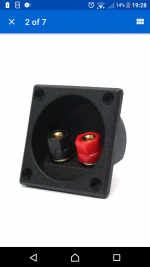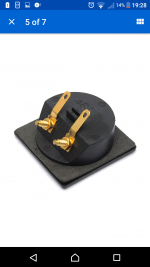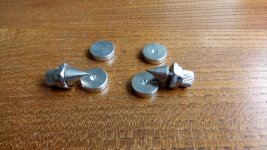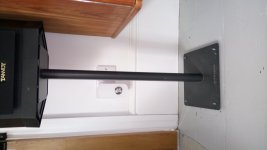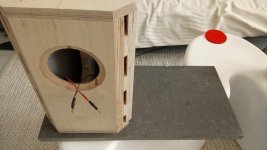Speaker terminal posts
These are so cheap, I mean they look cheap. But you're suggestion is that this is better?
And for the Trapezoids if i was to go separate posts you think these are the ones to go for?
https://www.hificollective.co.uk/binding-posts/eti-research-bp-50c-binding-post.html
These are so cheap, I mean they look cheap. But you're suggestion is that this is better?
And for the Trapezoids if i was to go separate posts you think these are the ones to go for?
https://www.hificollective.co.uk/binding-posts/eti-research-bp-50c-binding-post.html
Attachments
Last edited:
These are so cheap, I mean they look cheap. But you're suggestion is that this is better?
They are decidedly cheesy looking but to keep them cheap they use a minimum amount of metal which is what gives them their sonic advantage. The small terminal cup makes them a pain to hand tighten if you are using bare wire of spades but need a minimum size hole in the box. They are super for use with the pomona dual plugs.
And for the Trapezoids if i was to go separate posts you think these are the ones to go for? … eti-research-bp-50c-binding-post
If cost is no object & you want the best, yes, those would be my choice. I have successfully retrofitted the earlier generation into a terminal cup with standard spacing. A customer build with the similar concept WBT posts showed that ¾” spacing could not be done (he also supplied an exotic version of the CAT5 wiring we use).
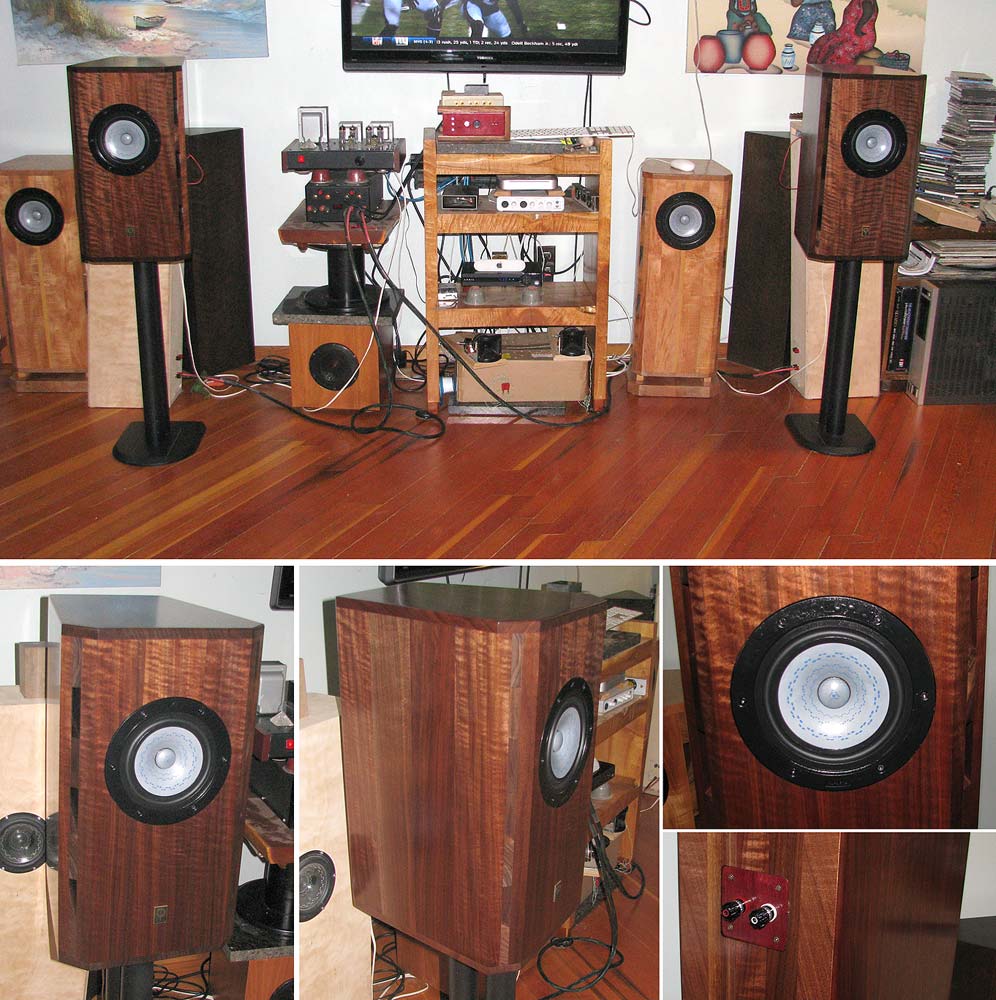
dave
They are decidedly cheesy looking but to keep them cheap they use a minimum amount of metal which is what gives them their sonic advantage. The small terminal cup makes them a pain to hand tighten if you are using bare wire of spades but need a minimum size hole in the box. They are super for use with the pomona dual plugs.
Ok when i see pictures and you explain it, i can see why. Pictures are very helpful for me! I generally like using banana plugs, but then i guess again too much metal, so spades would be ideal in this situation. Key thing learnt is minimum amount of metal and a solid quality cable.
If cost is no object & you want the best, yes, those would be my choice. I have successfully retrofitted the earlier generation into a terminal cup with standard spacing. A customer build with the similar concept WBT posts showed that ¾” spacing could not be done (he also supplied an exotic version of the CAT5 wiring we use).
The next build i do i will be sure to source good connectors and high quality silver solid wire. Next time i can design and machine a nice back plate and place the connectors nicely.

dave
In general i'm happy with the build so far, in the next build i plan to do the wadding differently, use your advice for the connectors and wires then test and compare them using Room EQ, i also like the FAST towers Dave, my original plan was to also build these also with the Trapz. Something to discuss and plan with you.
Stands, bases and spikes
Whats your thoughts on using spikes? Was thinking of putting these on the bottom of the speaker bases? Or using a slab of granite on top of my speaker stands?
So spikes on the enclosure, then onto the slab of granite then on the stands?
I may then try them without the stands on my side cabinet.
Whats your thoughts on using spikes? Was thinking of putting these on the bottom of the speaker bases? Or using a slab of granite on top of my speaker stands?
So spikes on the enclosure, then onto the slab of granite then on the stands?
I may then try them without the stands on my side cabinet.
Attachments
Last edited:
OK, since you asked - I avoid spikes whenever possible, and use Feltac or similar PSA soft felt pad, or Blutack putty on smaller speakers, and felt or teflon furniture gliders on larger floorstanders or stands.
I've ruined far too many carpets and flooring surfaces with spikes - it's too easy for one of those protecting cups to go astray when moved, and I've frankly yet to hear a blind test proving their efficacy. Now, mass loading the hollow pipe / tube section of a metal stand is a different story.
just one old fart's opinion - YMMV
I've ruined far too many carpets and flooring surfaces with spikes - it's too easy for one of those protecting cups to go astray when moved, and I've frankly yet to hear a blind test proving their efficacy. Now, mass loading the hollow pipe / tube section of a metal stand is a different story.
just one old fart's opinion - YMMV
OK, since you asked - I avoid spikes whenever possible, and use Feltac or similar PSA soft felt pad, or Blutack putty on smaller speakers, and felt or teflon furniture gliders on larger floorstanders or stands.
Agreed, spikes can be a nightmare, i was thinking of using something called SUGRU
Buy
| Sugru
if you have a chance check it out.
I've ruined far too many carpets and flooring surfaces with spikes - it's too easy for one of those protecting cups to go astray when moved, and I've frankly yet to hear a blind test proving their efficacy. Now, mass loading the hollow pipe / tube section of a metal stand is a different story.
I filled the hollow pipes with sand in my stands, i was thinking adding a granite sheet on top with also help.
I can always put the spikes on and test it, considering the ends are flush mounted and i can remove them if necessary.
just one old fart's opinion - YMMV
I highly regard both yours and Dave's opinions!
...something called SUGRU
I have seen that before. It is interesting.
dave
I have seen that before. It is interesting.
dave
Thoughts on Atabites instead of sand?
Atabites SMD-Z 7.5HD Inert Filler | Atacama Audio UK
Speaker wire
So i am now changing the speaker wire, connectors for the enclosure.
Thoughts on using 99.99% pure silver wire?
99.99% Pure Silver Wire Teflon Dielectric for DIY Audio Cables 24AWG | eBay
So i am now changing the speaker wire, connectors for the enclosure.
Thoughts on using 99.99% pure silver wire?
99.99% Pure Silver Wire Teflon Dielectric for DIY Audio Cables 24AWG | eBay
Why?? Copper is cheaper and effective. Silver has no benefit here.
Looking forward to your listening impressions and measurements
Just because it sounds kool to say " I used pure silver for my wiring"
Well also because I want to have the best quality, and use a high quality speaker cable. Maybe silver plate copper wire?
If you have too much money,.. consider a charity
Regular copper is good and more importantly it's sufficient for the purpose.
Hahahaha ok kool Don! Next week should be all finished I'll put all my measurements and results on here
There is a lot of snake oil in cables, so i usually stay out of discussions on wire. This is solid and skinny, and silver oxide is still a conducter unlike copper oxide. It is a fairly low entry price, one would need to diectly compare it against a piece of the same quality copper to pick what you like, but i see no problems with it. Now if it was cry-treated as well...
dave
dave
as someone who has listened to a lot of cable...
... there are merits to many. Remember though that a cable has resistance (more correctly impedance), inductance and capacitance. Any two will create a filter of some sort.
To me this is often the crux of the argument many who suggest that there are no differences in cable fail to "see". Now as to the ability for one to hear differences or the validity of whether one cable is superior to another I take the position that "the beauty is in the eye of the beholder". I've done cable comparisons and 'quality" reviews when I wrote for an online audio 'zine. To me there are noticeable differences, but it truly depends on how transparent one's system is and how well you know its signature sound.
I also believe that there is a lot of hype in the high performance cable aftermarket. SO for any with questions regarding cabling I offer the following ideas (sorry for the bulleted lists, Dave. I know you hate them) which I have stated before and which it seems that most cable designers can agree:
Most wire can be suitable based on the quality of conductors. Even cheap cables can now boast 99.999% purity. If copper, tin the ends (for speaker cable) and just use the tinned ends in a binding post. for ICs, tin the ends and ensure the connectors have been properly heated to allow for a good electrical joint to occur. Buy the best connectors you can afford. These can often minimize the likelihood of a bad fir for an RCA or bullet connector. Argue which is best all you want, but there have been enough industry 'standards' that have been used universally and are universally 'good'.
The use of good conductors, et al, and good mechanical connectors can be for naught unless the folks terminating the cables care about the quality of their work, ensuring that no cold solder joints exist. I personally care not whether the 'terminator' is a Chinese (or any other Asian) factory worker, or one in the US, Europe, or Canada (or elsewhere), but I do care that they are given the time to build the cables correctly with appropriate care.
Shields can have a profound effect on the sound as well. Some cables need the shield, some don't (it is RF and system dependent). Anything that one can do to help minimize these problems if apparent is a good thing.
And now to the one point that many may choose to ignore... the dielectric. Dielectrics have a profound effect on electrical fields, and it is these fields that transport the signals. Te lower the dielectric constant the less the fields are perturbed and the more intact the signal will be.
and now... spikes? sorbothane? What to use between a speaker and whatever is supporting it.
... there are merits to many. Remember though that a cable has resistance (more correctly impedance), inductance and capacitance. Any two will create a filter of some sort.
To me this is often the crux of the argument many who suggest that there are no differences in cable fail to "see". Now as to the ability for one to hear differences or the validity of whether one cable is superior to another I take the position that "the beauty is in the eye of the beholder". I've done cable comparisons and 'quality" reviews when I wrote for an online audio 'zine. To me there are noticeable differences, but it truly depends on how transparent one's system is and how well you know its signature sound.
I also believe that there is a lot of hype in the high performance cable aftermarket. SO for any with questions regarding cabling I offer the following ideas (sorry for the bulleted lists, Dave. I know you hate them) which I have stated before and which it seems that most cable designers can agree:
- use a cable with good quality conductors using appropriate geometry;
- use a cable with the best dielectric possible;
- use a cable that uses good (if not the best) connectors (if any) you can afford. Sometimes bare wire is preferred;
- use a cable that has been carefully constructed using good soldering practices (quality and pride in workmanship);
- use a cable that is shielded if required (YMMV).
Most wire can be suitable based on the quality of conductors. Even cheap cables can now boast 99.999% purity. If copper, tin the ends (for speaker cable) and just use the tinned ends in a binding post. for ICs, tin the ends and ensure the connectors have been properly heated to allow for a good electrical joint to occur. Buy the best connectors you can afford. These can often minimize the likelihood of a bad fir for an RCA or bullet connector. Argue which is best all you want, but there have been enough industry 'standards' that have been used universally and are universally 'good'.
The use of good conductors, et al, and good mechanical connectors can be for naught unless the folks terminating the cables care about the quality of their work, ensuring that no cold solder joints exist. I personally care not whether the 'terminator' is a Chinese (or any other Asian) factory worker, or one in the US, Europe, or Canada (or elsewhere), but I do care that they are given the time to build the cables correctly with appropriate care.
Shields can have a profound effect on the sound as well. Some cables need the shield, some don't (it is RF and system dependent). Anything that one can do to help minimize these problems if apparent is a good thing.
And now to the one point that many may choose to ignore... the dielectric. Dielectrics have a profound effect on electrical fields, and it is these fields that transport the signals. Te lower the dielectric constant the less the fields are perturbed and the more intact the signal will be.
and now... spikes? sorbothane? What to use between a speaker and whatever is supporting it.
What to use between a speaker and whatever is supporting it?
guys,
there is a general misconception (I think anyways) about what we are trying to do with materials/objects between a speaker and a stand, and a speaker stand and a floor.
There are two major types of 'footers" or whatever one might wish to call these things based on the desired effect one is seeking:
Sorbothane and similar stuff provides a 'soft coupling' of the loudspeaker from the mechanical environment and can provide some acoustical isolation as well. Speaker or component coupling is desirable when there is a good mechanical path to a dense, heavy object. In houses that usually means the foundation. Think of coupling as 'mass coupling'. The object is so massive that it cannot be easily excited thus remaining firmly in place. A suspended turntable might be a good example of a piece of equipment that can benefit from mass coupling (assuming that the suspension is capable of isolating the platter/tonearm system from its environment and the floors are robustly supported). On the other hand, a suspension-less turntable system may benefit from the use of isolation products such as sorbothane (et al) particularly if the floors are a little 'soft' or 'spongey'
guys,
there is a general misconception (I think anyways) about what we are trying to do with materials/objects between a speaker and a stand, and a speaker stand and a floor.
There are two major types of 'footers" or whatever one might wish to call these things based on the desired effect one is seeking:
- the isolation of the speaker (or for that matter any audio component) from it's mechanical and acoustical environment and;
- the coupling of a speaker (or other audio component) to its mechanical environment
Sorbothane and similar stuff provides a 'soft coupling' of the loudspeaker from the mechanical environment and can provide some acoustical isolation as well. Speaker or component coupling is desirable when there is a good mechanical path to a dense, heavy object. In houses that usually means the foundation. Think of coupling as 'mass coupling'. The object is so massive that it cannot be easily excited thus remaining firmly in place. A suspended turntable might be a good example of a piece of equipment that can benefit from mass coupling (assuming that the suspension is capable of isolating the platter/tonearm system from its environment and the floors are robustly supported). On the other hand, a suspension-less turntable system may benefit from the use of isolation products such as sorbothane (et al) particularly if the floors are a little 'soft' or 'spongey'
- Status
- This old topic is closed. If you want to reopen this topic, contact a moderator using the "Report Post" button.
- Home
- Loudspeakers
- Full Range
- Trapezoid mini Onken&Slim GR dMar-Ken builds
